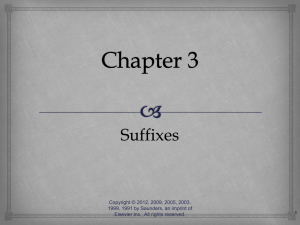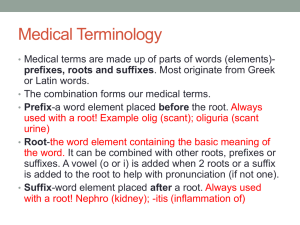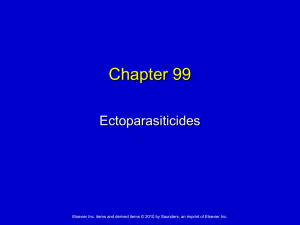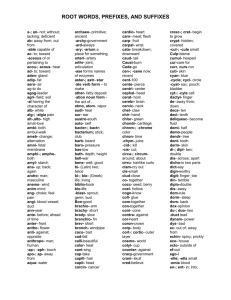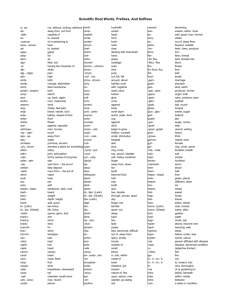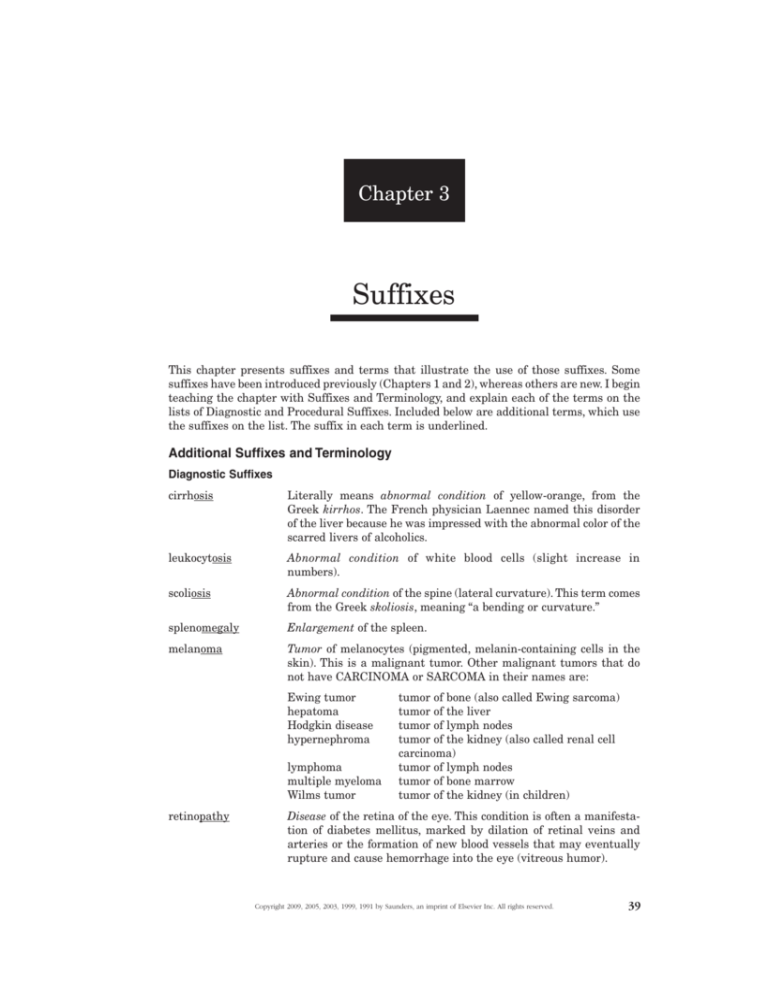
Chapter 3
Suffixes
This chapter presents suffixes and terms that illustrate the use of those suffixes. Some
suffixes have been introduced previously (Chapters 1 and 2), whereas others are new. I begin
teaching the chapter with Suffixes and Terminology, and explain each of the terms on the
lists of Diagnostic and Procedural Suffixes. Included below are additional terms, which use
the suffixes on the list. The suffix in each term is underlined.
Additional Suffixes and Terminology
Diagnostic Suffixes
cirrhosis
Literally means abnormal condition of yellow-orange, from the
Greek kirrhos. The French physician Laennec named this disorder
of the liver because he was impressed with the abnormal color of the
scarred livers of alcoholics.
leukocytosis
Abnormal condition of white blood cells (slight increase in
numbers).
scoliosis
Abnormal condition of the spine (lateral curvature). This term comes
from the Greek skoliosis, meaning “a bending or curvature.”
splenomegaly
Enlargement of the spleen.
melanoma
Tumor of melanocytes (pigmented, melanin-containing cells in the
skin). This is a malignant tumor. Other malignant tumors that do
not have CARCINOMA or SARCOMA in their names are:
Ewing tumor
hepatoma
Hodgkin disease
hypernephroma
lymphoma
multiple myeloma
Wilms tumor
retinopathy
tumor of bone (also called Ewing sarcoma)
tumor of the liver
tumor of lymph nodes
tumor of the kidney (also called renal cell
carcinoma)
tumor of lymph nodes
tumor of bone marrow
tumor of the kidney (in children)
Disease of the retina of the eye. This condition is often a manifestation of diabetes mellitus, marked by dilation of retinal veins and
arteries or the formation of new blood vessels that may eventually
rupture and cause hemorrhage into the eye (vitreous humor).
Copyright 2009, 2005, 2003, 1999, 1991 by Saunders, an imprint of Elsevier Inc. All rights reserved.
39
40
INSTRUCTOR’S RESOURCE MANUAL WITH TEACH LESSON PLANS FOR MEDICAL TERMINOLOGY: A SHORT COURSE
osteopathy
Disease of bones. More commonly, this term refers to a system of
therapy involving manipulation of the skeletal system. It is founded
on the theory that the body is capable of producing its own remedies
against disease when its structure is normal and it has proper
nutrition and a favorable environment.
leukorrhea
White discharge (from the vagina).
pyorrhea
Flow of pus. Collection of purulent material from infected tooth sockets, related to inflammation and disease of gums.
seborrhea
Excessive discharge of sebum (oil) from the skin, forming greasy
scales or plugs on the body.
steatorrhea
Discharge of fat in the feces.
multiple sclerosis
Hardening of nerve fibers (axons of nerve cells). Scar tissue forms on
nerve cells in scattered places in the brain and spinal cord. It causes
weakness in muscles, often leading to loss of muscle coordination.
otosclerosis
Abnormal formation (hardening) of new bone around a structure
(oval window) in the inner ear. This prevents the stapes (middle ear
bone) from moving and results in loss of hearing.
albuminuria
Protein (albumin) in the urine (abnormal condition).
glycosuria
Sugar in the urine (abnormal condition).
pyuria
Pus in the urine (abnormal condition).
Procedural Suffixes
endarterectomy
Removal of the inner lining of an artery (to remove plaque).
vitrectomy
Removal of the vitreous humor (performed as treatment for diabetic
retinopathy).
abdominocentesis
Surgical puncture to remove fluid from the abdomen. Also called a
paracentesis.
acetabuloplasty
Surgical repair of the acetabulum (hip socket).
arthroplasty
Surgical repair of a joint.
blepharoplasty
Surgical repair of the eyelid.
tympanoplasty
Surgical repair of the eardrum.
valvuloplasty
Surgical repair of a valve within the heart.
ileostomy
Opening of the ileum to the outside of the body. This may be
temporary or permanent. When it is done in conjunction with
removal of the colon and anus, it is always permanent.
hydrotherapy
Treatment with water; whirlpool baths.
psychotherapy
Treatment of the mind.
choledocholithotomy
Incision of the common bile duct (CHOLEDOCH/O) to remove a
stone (LITH).
episiotomy
Incision of the perineum (area between the anus and the vagina).
This is done to facilitate delivery of the infant.
myringotomy
Incision of the eardrum to provide drainage of purulent collections
in the middle ear.
nephrolithotomy
Incision of the kidney to remove a stone.
Copyright 2009, 2005, 2003, 1999, 1991 by Saunders, an imprint of Elsevier Inc. All rights reserved.
Name
Handout 3.1
Chapter 3 Multiple Choice Quiz
❏
❏
❏
❏
❏
❏
1. -osis means:
A. inflammation
B. tumor
C. pain
D. abnormal condition
E. visual examination
2. Blood infection:
A. anemia
B. septicemia
C. meningitis
D. hematoma
E. hemorrhage
❏
❏
3. Ear pain:
A. colitis
B. rhinalgia
C. myalgia
D. arthritis
E. otalgia
❏
4. A condition in which blood is
held back from an organ:
A. ischemia
B. uremia
C. hematuria
D. leukemia
E. menorrhea
❏
5. A benign tumor of muscle is a(an):
A. adenoma
B. adenocarcinoma
C. myoma
D. myosarcoma
E. myocardial infarction
6. Renal failure leads to this
abnormal blood condition:
A. vasculitis
B. cystitis
C. menorrhagia
D. thrombosis
E. uremia
❏
❏
7. Enlargement of the liver:
A. hepatomegaly
B. nephritis
C. hepatitis
D. cardiomegaly
E. nephromegaly
8. Inflammation of the membranes
around the brain and spinal cord:
A. neuralgia
B. encephalitis
C. pleuritis
D. meningitis
E. encephalopathy
9. The large intestine is called the:
A. larynx
B. pharynx
C. esophagus
D. trachea
E. colon
10. Disease of heart muscle:
A. myosarcoma
B. arthropathy
C. cardiomyopathy
D. nephropathy
E. neuritis
11. A cancerous tumor of glandular
(epithelial) cells is called:
A. leukemia
B. hematuria
C. adenoma
D. adenocarcinoma
E. sarcoma
12. Discharge of blood during the
menstrual period is called:
A. hemorrhage
B. menorrhea
C. rhinorrhea
D. anemia
E. hematuria
Copyright 2009, 2005, 2003, 1999, 1991 by Saunders, an imprint of Elsevier Inc. All rights reserved.
41
❏
❏
❏
❏
❏
❏
42
13. A suffix meaning a condition of
hardening is:
A. -centesis
B. -arteri/o
C. -pathy
D. -plasty
E. -sclerosis
❏
14. Pertaining to the groin:
A. inguinal
B. renal
C. pelvic
D. peritoneal
E. lateral
❏
15. Condition of blood in the urine:
A. uremia
B. menorrhagia
C. hematuria
D. hematology
E. ischemia
❏
16. A myocardial infarction is a(an):
A. stroke
B. heart attack
C. disease of the brain
D. enlargement of the liver
E. inflammation of a joint
❏
17. A condition that lasts for a long
time is called:
A. acute
B. septic
C. lateral
D. coccygeal
E. chronic
18. A suffix that means resection is:
A. -tomy
B. -plasty
C. -ectomy
D. -stomy
E. -therapy
❏
❏
19. Surgical puncture to remove
fluid from the sac around the
fetus is:
A. arthrocentesis
B. arteriosclerosis
C. hysterectomy
D. laparotomy
E. amniocentesis
20. Removal of a fallopian tube:
A. hysterotomy
B. colectomy
C. thoracocentesis
D. salpingectomy
E. oophorectomy
21. X-ray record of the spinal cord:
A. mammogram
B. myelogram
C. mammography
D. electromyogram
E. arthrogram
22. Removal of pharyngeal lymph
tissue:
A. tonsillectomy
B. mastectomy
C. nephrectomy
D. neurotomy
E. tracheotomy
23. Surgical repair of breast tissue:
A. hysterosalpingectomy
B. mastitis
C. mammography
D. mammoplasty
E. rhinoplasty
24. Separation of waste (urea) from
the blood by filtration through a
machine:
A. electroencephalography
B. arthrocentesis
C. peritoneal dialysis
D. abdominocentesis
E. hemodialysis
Copyright 2009, 2005, 2003, 1999, 1991 by Saunders, an imprint of Elsevier Inc. All rights reserved.
❏
❏
25. Combining form for blood vessel:
A. angi/o
B. erythr/o
C. hem/o
D. leuk/o
E. arthr/o
26. Creation of a new opening from
the windpipe to the outside of
the body:
A. laryngotomy
B. pharyngotomy
C. laparoscopy
D. tracheostomy
E. colostomy
❏
❏
27. Treatment using drugs:
A. chemotherapy
B. radiotherapy
C. hemodialysis
D. angioplasty
E. myelography
28. Incision of the abdomen:
A. arthrotomy
B. abdominoplasty
C. cholecystectomy
D. laparotomy
E. craniotomy
Copyright 2009, 2005, 2003, 1999, 1991 by Saunders, an imprint of Elsevier Inc. All rights reserved.
43
Name
Handout 3.2
Chapter 3 Spelling and Comprehension Quiz
I. Spelling
1.
11.
2.
12.
3.
13.
4.
14.
5.
15.
6.
16.
7.
17.
8.
18.
9.
19.
10.
20.
II. Comprehension: Match the terms listed above with their meanings below.
enlargement of the liver
inflammation of the urinary bladder
menstrual flow
ear pain
holding back blood from an area of the body
hardening of the arteries
malignant tumor of a gland
blood in the urine
disease of heart muscle
nerve pain
resection of a fallopian tube
high levels of urea in the blood
inflammation of membranes surrounding the brain
infection in the blood
surgical puncture to remove fluid from the chest
abnormal condition of death of cells
malignant tumor of muscle
surgical puncture to remove fluid from the sac surrounding the embryo
inflammation of the large intestine
bursting forth of blood
44
Copyright 2009, 2005, 2003, 1999, 1991 by Saunders, an imprint of Elsevier Inc. All rights reserved.
III. Match the combining form in Column I with its meaning in Column II.
Column I
1. hyster/o
2. ren/o
3. oophor/o
4. axill/o
5. inguin/o
6. vascul/o
7. mast/o
8. pneumon/o
9. myel/o
10. arthr/o
11. bronch/o
Column II
A. armpit
B. vein
C. breast
D. bronchial tube
E. kidney
F. joint
G. spinal cord and bone marrow
H. blood vessel
I. uterus
J. lung
K. groin
12. phleb/o
L. ovary
Copyright 2009, 2005, 2003, 1999, 1991 by Saunders, an imprint of Elsevier Inc. All rights reserved.
45
Name
Handout 3.3
Chapter 3 Review Quiz
I. Give meanings for the following suffixes:
1. -megaly
9. -therapy
2. -sclerosis
10. -plasty
3. -centesis
11. -gram
4. -stomy
12. -tomy
5. -uria
13. -ary
6. -rrhagia
14. -osis
7. -pathy
15. -eal
8. -lysis
II. Give meanings for the following combining forms:
1. angi/o
14. encephal/o
2. aden/o
15. carcin/o
3. arteri/o
16. cry/o
4. amni/o
17. chem/o
5. ren/o
18. isch/o
6. sarc/o
19. necr/o
7. my/o
20. radi/o
8. oste/o
21. septic/o
9. chron/o
22. vascul/o
10. inguin/o
23. thorac/o
11. mamm/o
24. ur/o
12. nephr/o
25. ather/o
13. men/o
46
Copyright 2009, 2005, 2003, 1999, 1991 by Saunders, an imprint of Elsevier Inc. All rights reserved.
III. Give combining forms for the following parts of the body:
1. gallbladder
3. urinary bladder
16. membranes
surrounding the
brain and spinal
cord
4. ovary
17. voice box
5. ear
18. blood
6. nose
19. hip bones
7. fallopian tube
20. skull
8. liver
21. windpipe
9. uterus
22. tonsils
2. armpit
10. colon
23. membrane
surrounding the
abdomen
11. heart
12. joint
24. esophagus
13. vein
14. bone marrow
15. spinal cord
25. tubes from
the trachea to
the lungs
Copyright 2009, 2005, 2003, 1999, 1991 by Saunders, an imprint of Elsevier Inc. All rights reserved.
47
Name
Handout 3.4
Chapter 3 Crossword Puzzle Quiz
1
5
2
3
6
4
7
8
9
10
11
12
13
14
15
Across
5. flow or discharge from the nose
8. suffix meaning pain
9. new opening into the colon from the
outside of the body
10. pain of a muscle
11. suffix meaning disease
12. x-ray record of the spinal cord
14. suffix meaning new opening
15. blood in the urine
48
Down
1. pain of a joint
2. excision or removal of tonsils
3. cancerous tumor
4. suffix meaning treatment
6. suffix meaning inflammation
7. suffix meaning hardening
13. suffix meaning tumor or mass
Copyright 2009, 2005, 2003, 1999, 1991 by Saunders, an imprint of Elsevier Inc. All rights reserved.
INSTRUCTOR’S RESOURCE MANUAL WITH TEACH LESSON PLANS FOR MEDICAL TERMINOLOGY: A SHORT COURSE
49
Handout 3.5
Chapter 3 Medical Word Doctor
Using combinations of the following combining forms and suffixes create a term to fill the
blanks in the following scenerios:
Combining Forms
angi/o
arteri/o
chem/o
cholecyst/o
col/o
cyst/o
hem/o
hemat/o
hepat/o
hyster/o
isch/o
lapar/o
mast/o
mening/o
my/o
myel/
nephr/o
oophor/o
salping/o
ur/o
Suffixes
-ectomy
-emia
-graphy
-itis
-megaly
-oma
-pathy
-plasty
-rrhage
-sclerosis
-scopy
-stomy
-therapy
-uria
1. Your patient has attempted suicide by slitting her wrists. She has cold, clammy skin,
is dizzy and pale, and has low blood pressure. You apply a tourniquet to stop the
.
2. Your patient’s colon is inflamed and needs to heal. You suggest a temporary
to divert the feces.
3. Physical examination of your patient with liver disease reveals an enlargement of the
liver known as
.
4. Following surgical treatment of breast cancer with
recommend
, you
, which is adjuvant (assisting) treatment
using drugs to kill any tumor cells circulating in the bloodstream.
Copyright 2009, 2005, 2003, 1999, 1991 by Saunders, an imprint of Elsevier Inc. All rights reserved.
50
INSTRUCTOR’S RESOURCE MANUAL WITH TEACH LESSON PLANS FOR MEDICAL TERMINOLOGY: A SHORT COURSE
5. Plaque that collects in coronary vessel walls and leads to thickening and loss of elasticity
is
. This condition often causes decreased blood supply to
heart muscle, called
. You recommend x-ray visualization of the blood
vessels bringing blood to the heart, a procedure known as
. When
x-rays show blockage of one coronary artery, you suggest balloon
to
open the vessel and increase blood flow to the heart muscle.
6. Abdominal ultrasound examination reveals stones in your patient’s gallbladder,
which should now be removed. You recommend immediate surgical resection via
(minimally invasive surgery) to perform a
.
7. Blood tests on your patient show malignant disease of the bone marrow, which you
diagnose as multiple
.
8. Abdominal and pelvic CT scans of your patient reveal extensive ovarian carcinoma,
which has spread to the uterus. You recommend a bilateral
(surgical resection of the ovaries and fallopian tubes), as well as
(removal of the uterus).
9. Your patient has a stiff neck and blood tests show bacteria in the bloodstream and in the
fluid surrounding the brain and spinal cord. You suspect inflammation, make the correct
diagnosis of bacterial
, and treat your patient with antibiotics.
10. When your patient’s urinalysis reveals slight
you suspect
(blood in the urine),
(inflammation of the urinary bladder).
Copyright 2009, 2005, 2003, 1999, 1991 by Saunders, an imprint of Elsevier Inc. All rights reserved.
INSTRUCTOR’S RESOURCE MANUAL WITH TEACH LESSON PLANS FOR MEDICAL TERMINOLOGY: A SHORT COURSE
51
Chapter 3 Answers
Multiple Choice
Handout 3.1
1.
2.
3.
4.
5.
6.
7.
8.
9.
10.
D
B
E
A
C
E
A
D
E
C
15.
16.
17.
18.
19.
20.
21.
22.
23.
24.
C
B
E
C
E
D
B
A
D
E
11.
12.
13.
14.
D
B
E
A
25.
26.
27.
28.
A
D
A
D
Spelling and Comprehension Quiz
Handout 3.2
I. Spelling Words
1.
2.
3.
4.
5.
6.
7.
8.
9.
10.
11.
12.
13.
14.
15.
16.
17.
18.
19.
20.
adenocarcinoma
amniocentesis
arteriosclerosis
cardiomyopathy
colitis
cystitis
hematuria
hemorrhage
hepatomegaly
ischemia
meningitis
menorrhea
myosarcoma
necrosis
neuralgia
otalgia
salpingectomy
septicemia
thoracentesis
uremia
II. Comprehension
9
6
12
16
10
enlargement of the liver
inflammation of the urinary bladder
menstrual flow
ear pain
holding back blood from an area of the
body
3 hardening of arteries
1 malignant tumor of a gland
7 blood in the urine
4
15
17
20
11
18
19
14
13
2
5
8
disease of heart muscle
nerve pain
resection of a fallopian tube
high levels of urea in the blood
inflammation of membranes surrounding the brain
infection in the blood
surgical puncture to remove fluid from
the chest
abnormal condition of death of cells
malignant tumor of muscle
surgical puncture to remove fluid from
the sac surrounding the embryo
inflammation of the large intestine
bursting forth of blood
III. Matching
1.
2.
3.
4.
5.
6.
7.
8.
9.
10.
11.
12.
I
E
L
A
K
H
C
J
G
F
D
B
Copyright 2009, 2005, 2003, 1999, 1991 by Saunders, an imprint of Elsevier Inc. All rights reserved.
52
INSTRUCTOR’S RESOURCE MANUAL WITH TEACH LESSON PLANS FOR MEDICAL TERMINOLOGY: A SHORT COURSE
Review Quiz
III.
Handout 3.3
I.
1.
2.
3.
4.
5.
6.
7.
8.
9.
10.
11.
12.
13.
14.
15.
enlargement
hardening
surgical procedure to remove fluid
new opening (to form a mouth)
urination; condition of urine
bursting forth (of blood)
disease, condition
separation, destruction, breakdown
treatment
surgical repair
record
incision
pertaining to
abnormal condition
pertaining to
II.
1.
2.
3.
4.
5.
6.
7.
8.
9.
10.
11.
12.
13.
14.
15.
16.
17.
18.
19.
20.
21.
22.
23.
24.
25.
blood vessel
gland
artery
amnion
kidney
flesh
muscle
bone
time
groin
breast
kidney
menstruation
brain
cancerous
cold
drug, chemical
to hold back
death
x-rays
pertaining to infection
blood vessel
chest
urine; urinary tract
plaque, collection of fatty material
1.
2.
3.
4.
5.
6.
7.
8.
9.
10.
11.
12.
13.
14.
15.
16.
17.
18.
19.
20.
21.
22.
23.
24.
25.
cholecyst/o
axill/o
cyst/o
oophor/o
ot/o
rhin/o
salping/o
hepat/o
hyster/o
col/o
cardi/o
arthr/o
phleb/o
myel/o
myel/o
mening/o
laryng/o
hemat/o
pelv/o
crani/o
trache/o
tonsill/o
peritone/o
esophag/o
bronch/o
Copyright 2009, 2005, 2003, 1999, 1991 by Saunders, an imprint of Elsevier Inc. All rights reserved.
INSTRUCTOR’S RESOURCE MANUAL WITH TEACH LESSON PLANS FOR MEDICAL TERMINOLOGY: A SHORT COURSE
Crossword Puzzle Quiz
Handout 3.4
2
1
A
5
3
T
R H
6
I
4
C
N O R R H E
T
7
A
S
H
T
T
N
R
C
E
H
I
S
C
L
R
R
S
I
E
A
R
P
A
L
L
L
G
E
I
A
8
A
P A
I
A
N
9
C O L
O S
T O M Y
S
M
10
M Y
C
11
L G
A
L G
T H Y
I
A
S
O
12
M Y
14
S
T O M Y
E
13
L O G R A
M
M
15
H E M A
T
U R I
A
Medical Word Doctor
Handout 3.5
1.
2.
3.
4.
5.
6.
7.
8.
9.
10.
hemorrhage
colostomy
hepatomegaly
mastectomy; chemotherapy
arteriosclerosis; ischemia; angiography; angioplasty
laparoscopy; cholecystectomy
myeloma;
oophorsalpingectomy; hysterectomy
meningitis
hematuria; cystitis
Copyright 2009, 2005, 2003, 1999, 1991 by Saunders, an imprint of Elsevier Inc. All rights reserved.
53
54
INSTRUCTOR’S RESOURCE MANUAL WITH TEACH LESSON PLANS FOR MEDICAL TERMINOLOGY: A SHORT COURSE
Dictation Sentences
Medical terms that are in bold are found in the chapter. Italicized terms may be new to
students. Their definitions follow the paragraph.
1. Operative Report: Bronchoscopy
Findings: Bronchoscopy through the endotracheal tube showed a normal distal trachea.
The carina and the left and right tracheobronchial systems were entirely normal. All of
the segmental bronchi were widely patent inside the chest.
Carina: part of the trachea that branches to form the bronchial tubes
Distal: farthest from the beginning of an organ or tube
Endotracheal tube: an airway tube inserted through the mouth into the windpipe
Patent: open
2. Myocardial Infarction
A myocardial infarction, or heart attack, is an area of dead tissue in heart muscle. It can
occur when atherosclerosis blocks a coronary artery and occludes it. Ischemia follows as
blood fails to reach the heart muscle. Because the blood, carrying necessary food and oxygen, never reaches the heart muscle, necrosis or infarction occurs.
Coronary: pertaining to the heart
Occluded: closed off
3. Angiography and Angioplasty
Angiography visualizes the coronary arteries. X-ray images show arteriosclerosis after
contrast is injected into a blood vessel. Angioplasty may then be performed to open clogged
arteries. Using a catheter containing a balloon and a stent, angioplasty keeps a clogged
artery open and is an alternative to coronary bypass surgery (CABG).
Catheter: a tube for injecting or withdrawing fluid
Contrast: material injected to visualize parts of the body on an x-ray
Coronary bypass surgery (CABG): open heart surgery using veins and arteries in place of
clogged coronary arteries (coronary artery bypass graft)
Stent: slotted tube
4. Electroencephalogram Report
Interpretation: Abnormal EEG, characterized by bihemispheric slowing with some focality
noted in the right parietal area. This may be explained by diffuse metabolic disturbance in
the right hemisphere, as would be seen in a mass lesion or from a cerebrovascular accident. No evidence of any epileptic activity is seen.
Bihemispheric: pertaining to both (bi- = two) hemispheres or halves of the brain
Diffuse: becoming widely spread
Epileptic: pertaining to epilepsy or seizure disorder in the brain
Focality: localized area of abnormal nerve cell discharges
Hemisphere: half of the brain
Metabolic: pertaining to metabolism (chemical activity of cells)
Parietal: pertaining to the side and middle part of the cerebrum
Copyright 2009, 2005, 2003, 1999, 1991 by Saunders, an imprint of Elsevier Inc. All rights reserved.





